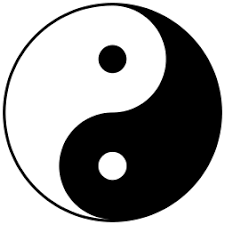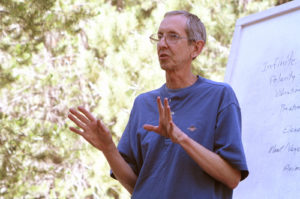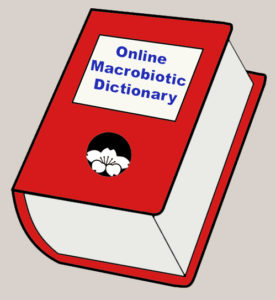
Completed Entries
Ground sesame paste made from hulled sesame seeds, less nutritious than sesame butter. Traditional Middle Eastern food.
Ancient Japanese term referring to the Chinese philosophical concept of Wuji that Ohsawa translated philosophically as “essential nature” or the “ether-universe before polarization” and thus the Infinite World or Infinity. In other words, it is “that which precedes the creation of life and produces and comprises the entire universe (all things visible and invisible).” Unique Principle, 20.
 A traditional Chinese symbol or diagram representing that there is yin within yang and yang within yin. Thus, yin and yang are both antagonistic and complementary to each other.
A traditional Chinese symbol or diagram representing that there is yin within yang and yang within yin. Thus, yin and yang are both antagonistic and complementary to each other.
Dried daikon pickles made in rice bran in winter and are useful for all yin types of diseases.
Liquid obtained in miso making, used in Japan as a thick sauce. Shoyu, or traditional soy sauce (mistakenly marketed as ‘tamari’), is made from wheat and soybeans and is not a miso product.
Flat, rectangular slices in vegetable cutting.
A term from Chinese philosophy that literally means “the path” or “the way.” It is the underlying principle of all things visible and invisible.
See Order of the Universe.
Taro (colocasia esculenta) is a large-leaved tropical Asian plant known as satoimo in Japan and albi in India. The roots from white (not red) taro are used as a plaster—a paste-like mixture of taro, ginger, and unbleached white flour applied to the body. Taro plasters are used mostly for helping to remove excess toxins from the body and for relieving pain and swelling.
See Cautionary note.
Japanese natural fiber brush used for scrubbing vegetable skins.
Small dried blue fish.
Condiment made by cooking minced burdock, carrot, and lotus root with miso until crumbly and dry.
Style of cooking batter-dipped foods in deep hot oil.
Ohsawa theorized that all disease could be cured in ten days by following a natural way of eating and drinking because the blood renews itself in a matter of months and because the blood feeds the disease. Ten days was believed to be enough time to turn the disease toward wellness. In actual practice, it takes much more time to cure most diseases of course.
Large bowl of rice topped with tempura.
Variation of the common phrase “ten thousand things” found in Taoist and Buddhist writings referring to all things in nature. Herman Aihara was fond on the old Chinese exaggeration of ten thousand soldiers coming over the hill when actually it was far fewer. See also, One Grain, Ten Thousand Grains.
In Zen Macrobiotics, Ohsawa published a list of ten dietary percentages of various foods that comprise healthy ways to eat in his view. These diets were numbered from minus 3 to seven, from which the diet number seven gets its name. Five of these diets are vegan and five include up to 30 percent animal foods.
To be conscious of a benefit received and to express gratitude for it. Ohsawa believed that all things are given to us from the Infinite (Oneness) and that this sets up a debt. “In truth, you cannot pay all that you owe in this life, because you have nothing but what you owe. You will be freed from debt if you distribute infinite joyfulness and thankfulness to everyone you meet throughout your life. This amounts to a real understanding of the structure of the infinite universe and its justice. The Earth gives back ten thousand grains in return for each grain she has received. ‘One grain, ten thousand grains’ is the biological law of this world.” Zen Macrobiotics, 48.
High protein cheese-like cake made from soybean liquid (soy milk) and a curdling agent, either calcium sulfate (gypsum) or nigari (magnesium chloride combined with calcium chloride, a byproduct of extracting salt from sea water). For eating, a natural tofu made with nigari is preferred, but any tofu will do for topical applications.
Mashed tofu used for skin abscesses, pain from burns, and acne.
See Cautionary note.
Mashed tofu, grated ginger, and unbleached white flour made into a paste-like consistency and used for head wounds and to reduce fevers, relieve pain, and decrease swelling.
See Cautionary note.
Ohsawa taught that tolerance, kindness or leniency for people, beliefs, or practices that differ from one’s own, is a virtue that is hard to achieve in everyday life. He maintained that one method for becoming more tolerant is macrobiotics, eating and living according to the order of the universe. Macrobiotic principles may be used to change one’s feelings of hatred to empathy, leading to greater tolerance.
Fine shreds of the sea vegetable kombu seasoned with rice vinegar and used in soups or as a condiment.
See Cautionary note.
See Cautionary note.
Poisons created by fermentation in the large intestines from excess protein or by eating chemical additives and preservatives. The body discharges these poisons in any way that it can, often through the skin.
The natural or artificial changing of one element into another. Ohsawa, who read about this theory in a book by French scientist Louis Kervran, claimed to have transmuted sodium into potassium using low temperature, pressure, and energy. He went on to conclude that the body can change one element into another and thus that the body can produce all that it needs from a simple diet. Ohsawa’s experiment has been duplicated but the theory has yet to be recognized by the scientific establishment.
Eating and drinking only that which is absolutely necessary to sustain life—not merely the detachment from all eating and drinking.
“True health is that which you yourself have created out of illness. Only if you have produced your own health can you know how wonderful it actually is. For this reason, many healthy people squander away their health; through ignorance, they spoil it without knowing its true value. He who knows the real worth of health spreads his joyous knowledge by telling others what he knows.” Macrobiotic Guidebook for Living, 54.
That which does not change. The only thing that doesn’t change in the finite (relative) world is the fact that everything changes, the implication being that the Infinite World is the real, true One.
Grated turnip used as a plaster for bruises.
See Cautionary note.
The unifying principle of yin and yang is a set of theorems used as tools to make daily decisions and shows that all apparent opposites are complementary; that is, connected. One can focus on either side of any pair or on the unification of them. The Unifying Principle is also called “the law of change” that governs all phenomena, visible and invisible. Evidence of this law is seen as opposites turn into each other; for examples, night becoming day, sickness becoming health, ignorance becoming wisdom, and so on—and all vice versa. The twelve theorems are:
- “Yin and Yang are two poles which enter into play when the infinite expansion manifests itself at the point of bifurcation (divided into two branches).” This is the beginning of the finite world as Infinity (nonduality) becomes two (duality). In other words, for anything to exist, its opposite must also exist.
- “Yin and Yang are produced continually by the transcendental expansion.” The finite world is dependent on Infinity (Oneness) for its continuous existence. Without the fundamental forces of opposition (yin and yang), nothing, including life, would be possible.
- “Yin is centrifugal. Yang is centripetal. Yin and Yang produce energy.” Yin activity is the outward, centrifugal force and produces expansion, lightness, cold, and so on. Yang activity is the inward, centrifugal force and produces contraction, heaviness, heat, and so on.
- “Yin attracts Yang. Yang attracts Yin.” Everything is attracted to its opposite. Someone who is more yin will be attracted to people and things that are more yang, and vice versa.
- “Yin and Yang combined in variable proportion produce all phenomena.” An infinite variety of combinations and proportions of yin and yang produces energy and all other things, both visible and invisible.
- “All phenomena are ephemeral, being of infinitely complex constitutions and constantly changing Yin and Yang components. Everything is without rest.” Everything is constantly changing its yin and yang characteristics—everything is restless. What is more yin one day can become more yang the next, and vice versa.
- “Nothing is totally Yin or totally Yang, even in the most apparently simple phenomenon. Everything contains a polarity at every stage of its composition.” Everything in this finite world is composed of both yin characteristics and yang characteristics. There is nothing that is all yin or all yang. In other words, yin and yang are not absolute qualities; they are relative qualities.
- “Nothing is neutral. Yin or Yang is in excess in every case.” If the yin characteristics dominate, then the thing is called “more yin.” If the yang characteristics dominate, then the thing is called “more yang.”
- “The force of attraction is proportional to the difference of the Yin and Yang components.” Two things that are far apart in terms of yin and yang force will have a much greater affinity than two things that are closer together in terms of yin and yang force.
- “Yin repels Yin and Yang repels Yang. The repulsion is inversely proportional to the difference of the Yin and Yang forces.” The more alike two things are in terms of yin and yang force, the more they will repel each other. The farther apart they are, the weaker the repulsion.
- “With time and space, Yin produces Yang, and Yang produces Yin.” At the extremity of development, something that is moving in the yin direction will begin moving in the yang direction, and vice versa. At some point in the depth of winter (more yin), the seasons begin to move toward summer (more yang).
- “Every physical body is Yang at its center and Yin toward the surface.” The surface (periphery) of everything is more yin and the center of the same thing is more yang, because yin is the representation of the outward force and yang is the representation of the inward force.
Projected Entries
Tabula rasa
Tao Te Ching (or Tao Te King)
Tapeworm
Taro
Tea compress
Tea, bancha
Teaching
Tempeh
Ten-day rice diet, the
Tenryu-ji
Thinking
Thumb sucking
Thyroid gland
Thyroxin
Tomatoes
Tomoe
Tooth decay
Tooth powder (dentie)
Toothache
Trachoma
Traditional
Transformation
Transition period
Travel
Triglycerides
Triple heater
Trycarboxylic acid
Tyryptophan
Tuberculosis
Tumors
Tuna
Turkey
Turnip
Twenty-fifth civilization
Tryosine
Questions or Comments?




